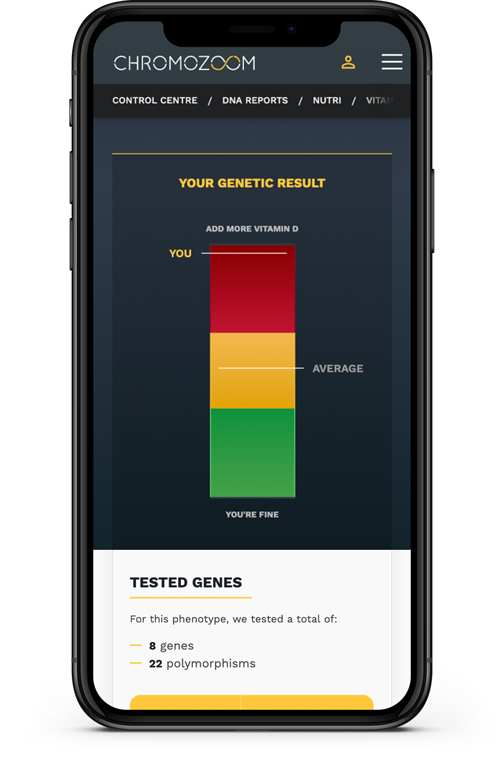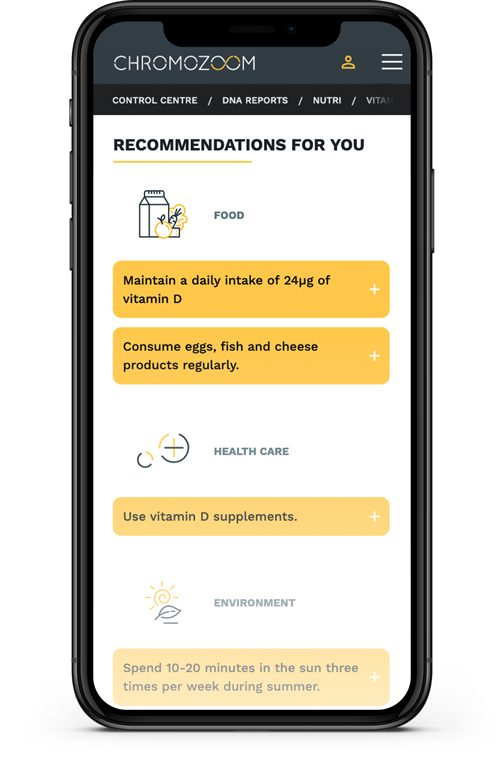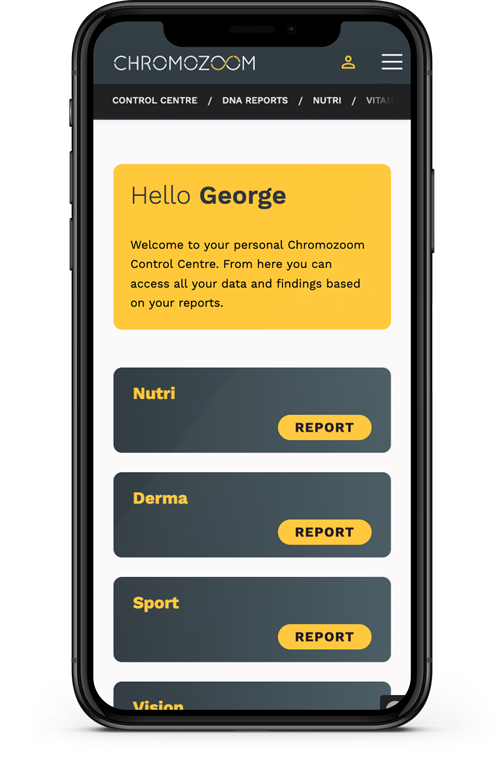Request a DEMO
If you are interested in our product, request access to demo account here. Leave us your email and you will receive login information.

Push the limits with ChromozoomSport

No matter the level, everyone wants to improve their sporting performance. But this can be a risky process – without a proper training plan, based on a detailed DNA test, your efforts can go to waste. With our Chromozoom Sport test, you can build a better training plan, including tailor-made recommendations and advice.

ChromozoomSport
Are you built for power and speed? Do you have Michael Jordan’s jumping genes? And can you justifiably blame your spare tyre on having fast-twitch muscle fibres? Explore your genetic potential for power and speed, compared with the average person’s.
Discover the difference between being naturally strong, and naturally fast. If you have natural muscle power, we’ll advise on how to optimise your training, to give you the edge over the opposition. Conversely, if the test reveals that your natural advantages lie elsewhere, is it still worth training for power / speed?
This report also advises on supplements and nutrients to boost power performance.
Does size matter when it comes to strength? Just as with chili peppers, the strongest muscles aren’t always the biggest.
If you have a high strength potential this means your muscles can contract strongly, allowing you to excel in strength sports, such as weight lifting, American football, and even boxing. In this DNA report, we’ll test for invisible factors that affect your muscle strength – including vitamin D activity, communication between muscle cells and nerves or immune system, how trainable muscle strength is and muscle recovery after exertion.
The final factor – growth of your muscles – links your muscle size to strengt
Are you naturally meaty – do you bulk up easily without trying? If so, you’d make a natural bodybuilder. We’ll test your DNA for four polymorphisms linked to body composition – including whether you have the “Hercules” gene, linked to greater muscle mass.
If you have high potential to grow muscles, working out can help you slim down by raising your basal metabolism. Conversely, if you’re naturally lightly muscled, we’ll advise on the best ways to train, including advice on nutritional supports for maximising muscle mass
Marathon runners and long-distance swimmers and cyclists tend to have endurance genes. Discover whether you share their advantage. We’ll also predict your baseline cardiorespiratory fitness levels, and ease of training for endurance events.
The baseline efficiency of your heart and lungs is 50% inherited. This is measured as your VO2 Max score. Olympic endurance champions have enviable baseline VO2 Max scores, which they have built on through persistent training. Training up your VO2 max levels can help your body ward off diabetes, high blood pressure, heart disease, age-related memory loss and chronic inflammation.
What do your genes say about how well your body responds to endurance training? How quickly can you improve your endurance, and how patient and persistent must you be in order to make gains? With regular training, how efficiently could your heart and lungs work? How easily could you increase your baseline VO2max, and therefore lower your resting heart rate? Clues to these answers all lie in your genes.
Muscle fatigue happens when free oxygen radicals accumulate in your muscles during exercise. Professional athletes are often genetically protected from muscle fatigue, due to their strong antioxidant systems. This allows them to bounce back between training sessions. If this is you, then you can sometimes push your muscles to the max.
Conversely, if you’re genetically prone to muscle fatigue you must train gently and avoid training when ill to avoid muscle damage and weakening your immune system. In this report, we advise you according to your genetic risk, including which antioxidants can help tired muscles regenerate.
During intense physical activity, the waste product lactate builds up in the muscle, causing muscle fatigue and eventually cramp. The anaerobic threshold is the fastest rate at which you can work out before lactate build ups. Athletes have pushed up their anaerobic threshold – they can efficiently clear lactate from their muscles, enabling them to go faster, harder and for longer.
If you are genetically prone to lactate build up, we’ll share our tips for what you can do before and after you work out – helping you perform better, and recover quickly.
Muscle fibres must get damaged first before they can grow in size or strength. During muscle damage, stem cells also known as satellite cells get activated and start to migrate to the site of injury to heal and grow new muscle fibres. Scientists believe that your genes influence how well these stem cells grow and work.
Strength athletes are genetically protected from muscle damage because they have very effective proteins involved in the inflammatory phase of recovery / remodelling. Find out whether you’re genetically prone to muscle damage. And explore what you can do – including nutritional support - to protect yourself.
How fast you recover after doing sport depends largely on your genes – we will test your DNA for several genetic variants linked to faster recovery times. Over 90% of all sports injuries involve bruised or strained muscles. If your DNA results reveals that you’re prone to lengthy recovery times, we have some solutions.
Simply follow our routines for before and after training sessions, and practices for keeping your muscles supple and relaxed.
Are you genetically prone to torn tendons and ligaments? How about Achilles tendon injuries? Or torn rotator cuffs (a common swimming injury)? Your personal tendency to tearing tendons and ligaments is about 40% inherited. Since tendons /ligaments are slow to repair, prevention is obviously better than cure.
Take this test to find out how well the metabolism in your tendon and ligament cells works. And how easily does the collagen protein in them regenerate itself? If you’re genetically prone to these injuries, follow our self-care advice to keep you actively playing your sport without enduring long outages for injuries to heal.
How quickly can increased physical activity help you normalise your blood lipids (cholesterol) levels? The answer lies partly in your genes. Some genetically lucky individuals see immediate improvements in their blood lipid profile when they take up regular exercise. But for others, it’s a slower process. If this is you, we recommend dietary measures that will speed up your cholesterol level’s response to exercise, and so cut this cardiovascular risk factor.
Our bodies have a natural weight they tend to veer towards. And for some lucky people, physical activity greatly lowers this baseline value. But even if your test reveals a low genetic potential to lose weight with exercise, we’ll give you tips to nudge along your progress through wiser choice of workouts frequency and intensity.
Everyone’s body has its own baseline settings for physiological parameters including blood pressure – but this is moveable according to how much physical activity you do. Up to one in five of the physiological links between exercise and blood pressure are at least partly genetic. So, while for many people exercise is the first line of defence against high blood pressure, about 20–30% of people find their high blood pressure is resistant to exercise. If your DNA test results show you’re in this category, we will suggest changes in diet and other alternatives to help normalise your blood pressure naturally.



The DNA collection kit serves as a tool for collecting the DNA sample from the comfort of your home.

ChromozoomSport
If you are interested in our product, request access to demo account here. Leave us your email and you will receive login information.